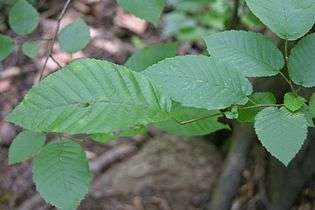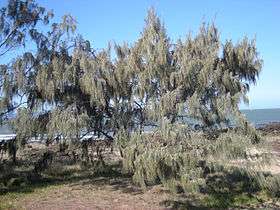Ironwood
Ironwood is a common name for a large number of woods that have a reputation for hardness. Usage of the name may (or may not) include the tree that yields this wood.
Some of the species involved
- Acacia estrophiolata (Southern ironwood), central Australia[1]
- Acacia stenophylla (Ironwood), Australia
- Androstachys johnsonii (Lebombo ironwood), southeastern Africa and Madagascar[2]
- Backhousia subargentea (Giant ironwood), eastern Australia[3]
- Carpinus caroliniana (American hornbeam), eastern North America[4]
- Casuarinaceae, she-oaks in general, Southeast Asia
- Casuarina equisetifolia (Beach ironwood), native from Burma south to Australia[5]
- Chionanthus foveolatus (Pock ironwood), native to southern Africa[6]
- Cynometra alexandri (Uganda ironwood), central and east Africa[7]
- Erythrophleum chlorostachys (Cooktown ironwood), native to northern Australia[8]
- Eusideroxylon zwageri (Borneo ironwood), southeast Asia
- Holodiscus discolor (Ocean spray), western North America[9]
- Krugiodendron ferreum (Black ironwood), Caribbean
- Libidibia ferrea (Brazilian ironwood), Brazil[10]
- Lignum vitae
- Lophira alata (Red ironwood), western and central Africa[11]
- Lyonothamnus floribundus (Catalina ironwood), in the rose family, Channel Islands of California[12]
- Mesua ferrea (Sri Lankan ironwood), southern and southeastern Asia[13]
- Nestegis apetala (Bastard ironwood), New Zealand and Norfolk Island[14]
- Olea capensis (Black ironwood), Africa[15]
- Olea woodiana (Black ironwood), eastern and southern Africa[16]
- Olneya tesota, Desert ironwood
- Ostrya knowltonii, Knowlton's hophornbeam
- Ostrya virginiana, Hophornbeam
- Parrotia persica, Persian ironwood
- Pemphis acidula, Maldivian ironwood
- Sideroxylon lanuginosum, Ironwood or Gum bully
- Tabebuia serratifolia, Ipê, Brazilian walnut, Lapacho, Yellow poui
- Vepris lanceolata, White ironwood, native to South Africa
- Xanthostemon verdugonianus, Philippine ironwood or Mangkono, endemic to the Philippines
Plants named ironwood

 Acacia stenophylla flowers
Acacia stenophylla flowers Carpinus caroliniana leaves
Carpinus caroliniana leaves Casuarina equisetifolia subsp. incana
Casuarina equisetifolia subsp. incana Chionanthus foveolatus leaves
Chionanthus foveolatus leaves- Eusideroxylon zwageri leaves
- Holodiscus discolor flowers






See also
- Black ironwood (disambiguation)
- Ironbark, various Eucalyptus spp.
- Iron tree (disambiguation)
- Sideroxylon, from sideros (σιδηρος) meaning "iron", and xylon (ξύλον) meaning "wood"
References
- ↑ "Acacia estrophiolata F. Muell.". FAO. July 9, 2008. Archived from the original on 2008-07-09.
- ↑ Yashe, Asavela; Hankey, Andrew (October 2014). "Androstachys johnsonii Prain". PlantzAfrica. SANBI.
- ↑ "Giant Ironwood - profile". Threatened species. New South Wales Office of Environment & Heritage. 2014-08-05.
- ↑ Metzger, F. T. (1990). "Carpinus caroliniana". In Burns, Russell M.; Honkala, Barbara H. Hardwoods. Silvics of North America. Washington, D.C.: United States Forest Service (USFS), United States Department of Agriculture (USDA). 2 – via Northeastern Area State and Private Forestry (www.na.fs.fed.us).
- ↑ Boland, D. J.; Brooker, M. I. H.; Chippendale, G. M.; McDonald, M. W. (2006). Forest trees of Australia (5th ed.). Collingwood, Vic.: CSIRO Publishing. p. 82. ISBN 0-643-06969-0.
- ↑ "Chionanthus foveolatus". Kew World Checklist of Selected Plant Families.
- ↑ "Cynometra alexandri". Wood Technical Fact Sheets. USDA Forest Service.
- ↑ Boland, D.J.; Brooker, M.I.H; Chippendale, G.M.; Hall, N.; et al. (1984). Forest trees of Australia. Melbourne: CSIRO. p. 68.
- ↑ "Holodiscus discolor (Pursh) Maxim.". Plants Profile. USDA. 2008.
- ↑ "Caesalpinia ferrea Mart. ex Tul.". Germplasm Resources Information Network (GRIN). Agricultural Research Service (ARS), United States Department of Agriculture (USDA).
- ↑ "Azobe (Lophira alata)". Wildscreen Arkive.
- ↑ Erwin, D. M. & Schorn, H. E. (2000). "Revision of Lyonothamnus A.Gray (Rosaceae) from the Neogene of Western North America". International Journal of Plant Science. 161 (1): 179–193. doi:10.1086/314232.
- ↑ "Mesua ferrea L. – Clusiaceae". biotik.org.
- ↑ "Nestegis apetala". New Zealand Plant Conservation Network.
- ↑ "Olea capensis". Ecocrop. FAO.
- ↑ "Olea woodiana". Germplasm Resources Information Network (GRIN). Agricultural Research Service (ARS), United States Department of Agriculture (USDA).
This article is issued from
Wikipedia.
The text is licensed under Creative Commons - Attribution - Sharealike.
Additional terms may apply for the media files.